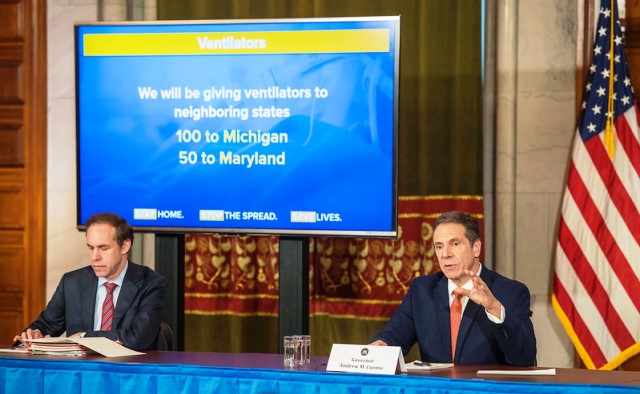
Image source: Office of Governor Andrew M. Cuomo via Flickr
Public relations experts and other commentators point to New York Gov. Andrew Cuomo’s COVID-19 communications as an example of how leaders should speak to the public during a crisis.
Business leaders and PR professionals can examine Cuomo’s press conferences for several crisis communications lessons. While the New York governor lacks flowery language and eloquent public speaking abilities, his communications style helps calm the public and accurately inform audiences. His communications style shows that florid language is not necessary for effective leadership.
Here’s an overview of some of those key lessons.
Start with Data – Explore the Facts
Cuomo starts his press conferences with numbers. He doesn’t whitewash the data or understate the seriousness of the situation. In one recent press conference, he said New York State had 53,000 ICU beds, and health experts predicted the state would need 140,000 over the next 14-21 days. Also, he said, New York State was short roughly 30,000 ventilators to treat acute cases of COVID-19. Besides informing the public, hard numbers increase the speaker’s authority.
“At a time of crisis, people are not looking for sugar-coated reassurances that everything is fine. They need to know the facts,” says Dan Sweet, director of public relations at RP3 Agency.
Make it Personal
Cuomo’s presentations are not entirely recitations of numbers. He refers to specific people to cut through the numbers and connect with viewers. He once said his sister called him in a panic, wanting a Covid-19 test at a time when there were almost none available. In another example, he explained that he named New York’s shelter-in-place law “Matilda’s Law” because he was thinking of his own mother’s health when he signed it, Sweet says.
The one or two percent who may die from this virus due to lack of ventilators are people’s mothers, fathers, grandparents, sisters and brothers, Cuomo said. He was thinking of “the 40-year-old breast cancer survivor with four kids and a compromised immune system” when making decisions, he said.
Build Trust with Transparency and Accountability
His forthrightness with facts shows he is being transparent, which earns public trust, says Dan Gardner, an expert on the psychology of judgment and communication.
In a crisis, leaders sometimes withhold information in the mistaken belief that people will react badly, even panic, if they’re given bad news, Gardner says. But leaders who aren’t forthcoming implicitly say to people, “I don’t trust you with this information.” When leaders don’t trust people, people don’t trust leaders.
Cuomo admitted that quarantines will cause businesses to close and took responsibility “If someone is unhappy, blame me,” he said.
“Shouldering responsibility isn’t merely honorable,” Gardner says. “It demonstrates you’re in charge and confident of your decisions.”
Take a Methodical Approach
In times of crisis, when people are shaken and disoriented, a linear and methodical communications approach is often more effective that other communications styles, explains Mark Murphy, founder of Leadership IQ, in Forbes.
A systematic, deliberate and thorough approach – what Murphy calls the functional approach — delivers a reassuring sense of calm and order. The functional style emphasizes process, detail, timelines and well-thought-out plans. Speakers communicate in a step-by-step fashion so nothing gets missed. Their vocal style tends to be calm and even, and their pacing is methodical.
“When you’re dealing with an anxious client, you need to slow your speech, and talk calmly and deliberately,” Murphy says.
In a recent press conference, Cuomo discussed the need for greater coordination between hospitals. He
- First discussed the problem of lack of coordination,
- Then described the kind of coordination that will be necessary,
- Then outlined specific actions that he and others would take.
Remember Body Language
Numerous studies show that body language and nonverbal communication deliver more than 70% of the message, write Alejandro Romero, LLYC partner and CEO for the Americas, and Gerard Guiu, LLYC director of international business development.
Cuomo has a steady gaze and powerful voice; his relaxed manner, and touches of humor, resonate with the public, and show empathy for the journalists covering his every press conference,” they write in PRovoke. “A master of intonation, Cuomo doesn’t hide his feelings.”
Bottom Line: Public speakers and communications professionals can learn valuable crisis communications lessons from New York Governor Andrew Cuomo’s recent press conferences. Perhaps most importantly, you don’t need glitzy presentations or flowery language to persuade and inform. Calmly and methodically relaying information is more effective during a crisis.
Download the 2020 Ultimate Guide to Media Monitoring, Measurement & Analytics for PR & Marketing

Michael Kling is manager of public relations, marketing and social media at Glean.info, a media monitoring and measurement service that provides customized media monitoring and PR analytics solutions.




